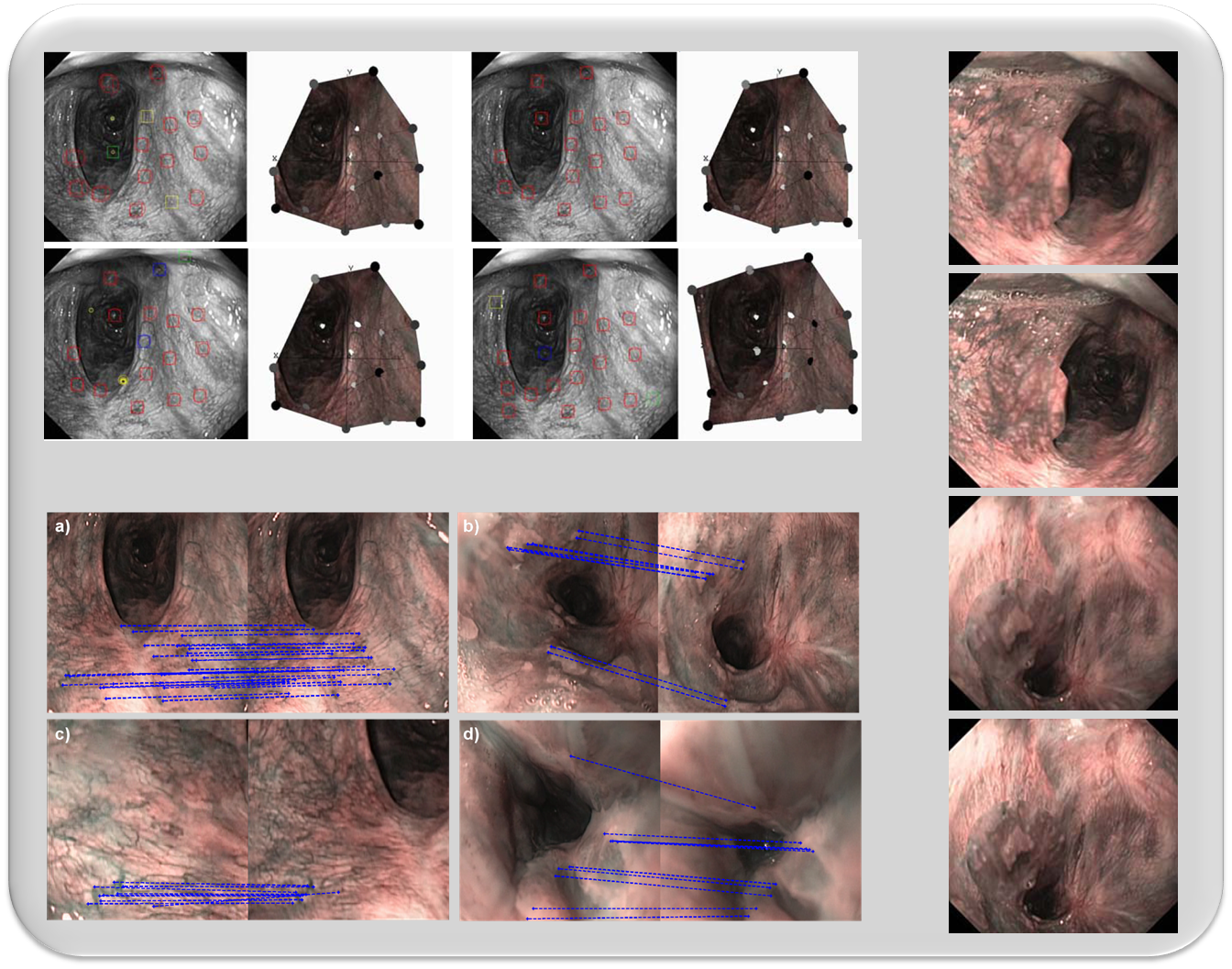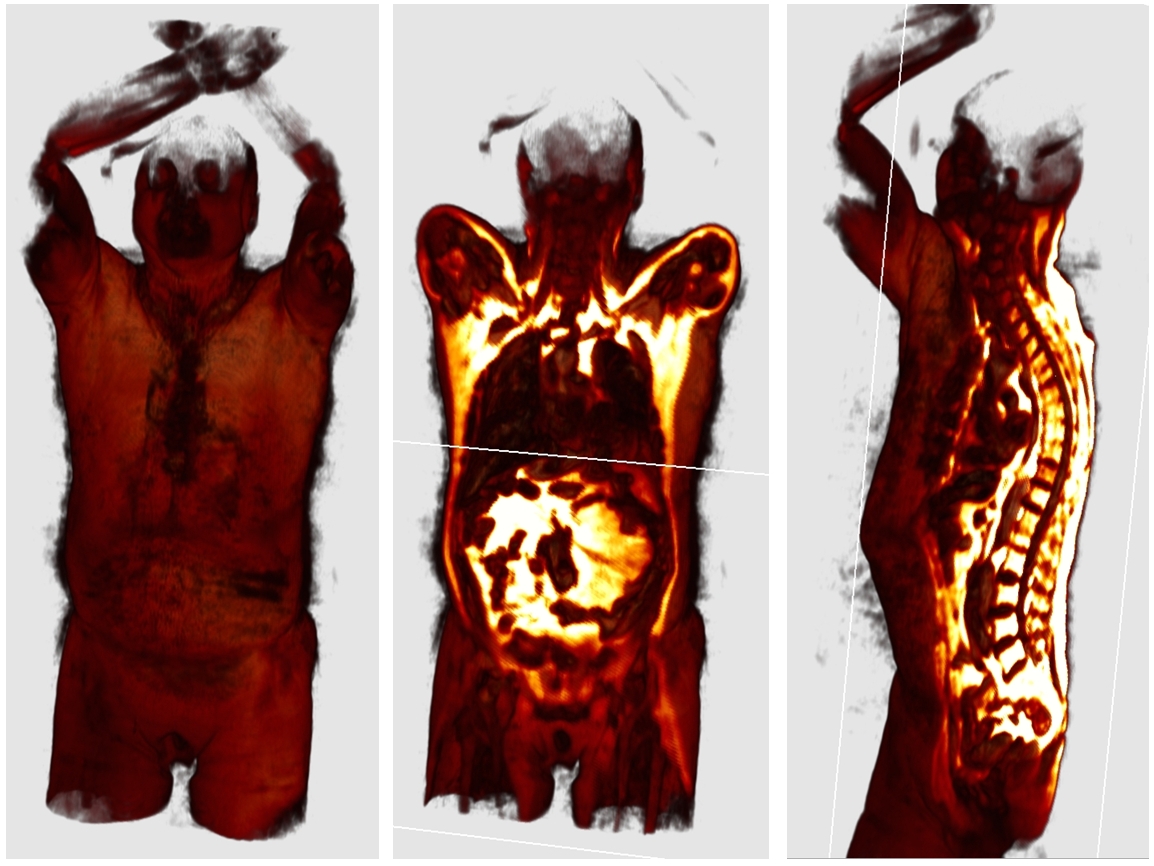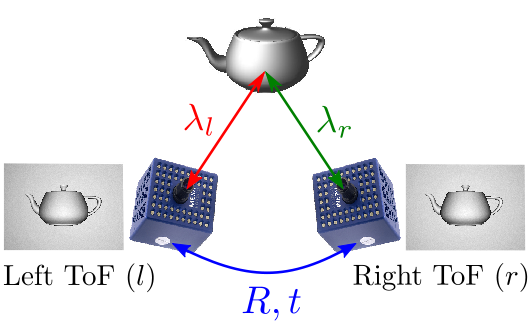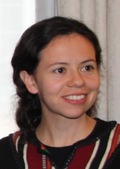Diana Mateus
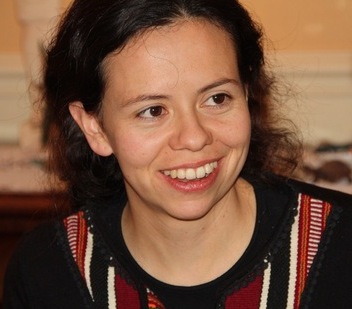
|
|
|
NEWS
- OPEN CALL FOR PAPERS for the MICCAI 2017 Workshop on Large-scale Annotation of Biomedical Data and Expert Label Synthesis LABELS 2017
- Link to our new Springer Volume *Deep Learning and Data Labeling for Medical Applications*.
Access the online version at Online Version
- Our paper "Learning Optimization Updates for Multimodal Registration" got one of the Young Scientist awards at MICCAI 2016 More Info
Research Interests
- Medical image analysis: ultrasound modeling, microscopic images.
- Machine Learning : Weak and unsupervised learning, manifold learning, similarity learning, clustering.
- Geometric computer vision: Multi-view Camera Systems, 3-D Reconstruction, Scene-flow, TOF and depth cameras.
- Shape Analysis: representation, matching and segmentation.
- Robotic Applications: visual control, navigation, localization.
Teaching
Summer Term 2017 Winter Term 2016- Practical Course Machine Learning in Medical Imaging
- Seminar on Deep Learning for Medical Applications
- Practical Course Machine Learning in Medical Imaging
- CAMP II
- Master Seminar Machine Learning for Computer Vision Applications
- Practical Course Machine Learning in Medical Imaging
- Master Seminar Machine Learning for Computer Vision Applications
- Computer Aided Medical Procedures (CAMP II)
- Master Seminar Machine Learning for Computer Vision Applications
- Computer Aided Medical Procedures (CAMP II)
- Master Seminar Machine Learning for Computer Vision Applications
- Computer Aided Medical Procedures (CAMP II)
- Master Seminar Machine Learning for Computer Vision Applications
Research projects at CAMP
Similarity/Metric/Distance Learning for Medical ApplicationsMany medical applications such as registration or tracking can be seen as the optimization of an objective function which involves a data term or similarity measure. Classical similarity measures rely for instance on image intensities, gradients or intensity statistics. In the case of noise or background clutter which is very frequent in the case of medical imaging, they might lead to registration/tracking errors. In this project, we investigate different approches and applications of learning a similarity measure directly from the data, leading to a more robust data term which is adapted to the image characteristics. |
Workflow Analysis Using 4D Reconstruction DataThis project targets the worklow analysis of an interventional room equipped with 16 cameras fixed on the ceiling. It uses real-time 3D reconstruction data and information from other available sensors to recognize objects, persons and actions. This provides complementary information to specific procedure analysis for the development of intelligent and context-aware support systems in surgical environments. |
Endoscopic Video ProcessingThe diagnosis and surveillance of several gastrointestinal (GI) diseases such as colateral or oesaphageal cancer are performed under endoscopic guidance. However, currently there exists no computer aided navigation tool to support these procedures. The goal of this project is to provide an advanced visualisation and automatic recognition tool in order to support the navigation and targeting in GI endoscopic procedures. The aim of the project is twofold: reconstructing the organ surface from endoscopic videos using monoSLAM and automatically recognising the biopsy locations to support the navigation and targeting in endoscopy. |
Organ RecognitionAutomatic localization of multiple anatomical structures in medical images provides important semantic information with potential benefits to diverse clinical applications. In this project, we investigate hierachical regression methods based on Random Forests and Random Ferns. Such hierarchical approaches permit to subdivide efficiently the feature space and to create a partition over it. In each cell of the resulting partition, data can be easily modeled using simple mathematical models such as constant or linear. The combination of these models over the whole partition results then in a complex non-linear model. |
Computational Sonography3D ultrasound imaging has high potential for various clinical applications, but often suffers from high operator-dependency and the directionality of the acquired data. State-of-the-art systems mostly perform compounding of the image data prior to further processing and visualization, resulting in 3D volumes of scalar intensities. This work presents computational sonography as a novel concept to represent 3D ultrasound as tensor instead of scalar fields, mapping a full and arbitrary 3D acquisition to the reconstructed data. The proposed representation compactly preserves significantly more information about the anatomy-specific and direction-depend acquisition, facilitating both targeted data processing and improved visualization. We show the potential of this paradigm on ultrasound phantom data as well as on clinically acquired data for acquisitions of the femoral, brachial and antebrachial bone. Further investigation will consider additional compact directional-dependent representations on the one hand and on the other hand modify Computational Sonography from working on B-Mode images to RF-envelope statistics, motivated by the statistical process of image formation. We will show the advantages of the proposed improvements on simulated ultrasound data, phantom and clinically acquired ultrasound data. |
Stereo Time-of-FlightThis paper describes a novel method to acquire depth images based on combining a pair of ToF (Time of Flight) cameras. As opposed to approaches that register point clouds posterior to the image acquisition, we propose to combine the measurements of the two cameras at the acquisition level. To do so, we actively control the infrared lighting of the scene such that the two cameras emit and measure the reflected infrared light first one after the other, and then simultaneously. Assuming the scene is static during these three stages and gathering the obtained depth measurements in each state, we derive a set of constraints that allow us to optimize the two depth images. In terms of hardware requirements, the cameras need to have access to the control of the infrared lights and should work with the same infrared wavelength and with exactly the same modulation frequency. A quantitative evaluation of the performance of the proposed method for different objects and setups is provided based on a simulation of the ToF cameras. Results on real images are also provided. In both simulation and real images the stereo-ToF acquisition is able to produce more accurate depth measurements. |
Human Motion Analysis using Time-of-Flight (ToF) CamerasTime-of-Flight cameras provide a novel means of acquiring depth information in a scene in real-time. In this project, we focus on analyzing human motion using this imaging device. We develop methods for capturing the full-body pose in 3D form ToF camera data and for recognizing activities performed by a person. In particular, we investigate learning-based approaches that allow us to predict full-body poses and classify performed activities based on prior knowledge learned in a training phase. We also explore methods for direct, discriminative pose estimation without relying on a training phase. |
Cross Modalities Image SynthesisOne of the interesting talks in the Generative and Discriminative Learning for Medical Imaging Tutorial in the last MICCAI 2014 was presented by Jerry Prince regarding Image Synthesis and cross-modalities, motivating us to work on such a challenging topic. In our project for MLMI course, we would like to implement kind of Supervised Dictionary Learning incorporating the global consistency, discriminative labeling, and the Transformation-invariant. |
Patient Monitoring for Neurological Diseases Using Wearable SensorsQuantitative analysis of human motion plays an important role for diagnosis, treatment planning and monitoring of neurological disorders, such as epilepsy, multiple sclerosis or Parkinson's disease. Stationary motion analysis systems in clinical environments allow acquisition of various human motion parameters based on inertial sensors or cameras. However, such systems do not permit to analyze patient movements in everyday-life situations over extended periods of time. Existing sys-tems using portable inertial sensors typically extract coarse-grained movement information, e.g. over-all activity indices. In this project, we investigate machine learning-based methods that allow us to recognize multiple activities and to track the human full-body pose from wearable inertial sensor data. We propose to employ a prior motion model to constrain the tracking problem from inertial sensors. Machine learning techniques, such as manifold learning and non-linear regression, allow us to build a prior motion model for each patient. The main component of the motion model is a low-dimensional representation of feasible human poses for the set of considered activities. After training, our method is able to recognize individual activities and to track the full-body pose of a patient, given only inertial sensor data. We estimate the current state of a person (activity type and exact pose in low-dimensional representation) by means of a particle filter. Using the learned representation of feasible poses for tracking significantly simplifies the search for suitable poses, as compared to exhaustively exploring the space of full-body poses. |
Activity Recognition and Pose Estimation using Wearable Inertial SensorsWe propose a method for human full-body pose tracking from measurements of wearable inertial sensors. Since the data provided by such sensors is sparse, noisy and often ambiguous, we use a compound prior model of feasible human poses to constrain the tracking problem. Our model consists of several low-dimensional, activity-specific motion models and an efficient, sampling-based activity switching mechanism. We restrict the search space for pose tracking by means of manifold learning. Together with the portability of wearable sensors, our method allows us to track human full-body motion in unconstrained environments. In fact, we are able to simultaneously classify the activity a person is performing and estimate the full-body pose. Experiments on movement sequences containing different activities show that our method can seamlessly detect activity switches and precisely reconstruct full-body pose from the data of only six wearable inertial sensors. |
BSc., MSc., and PhD Research Projects
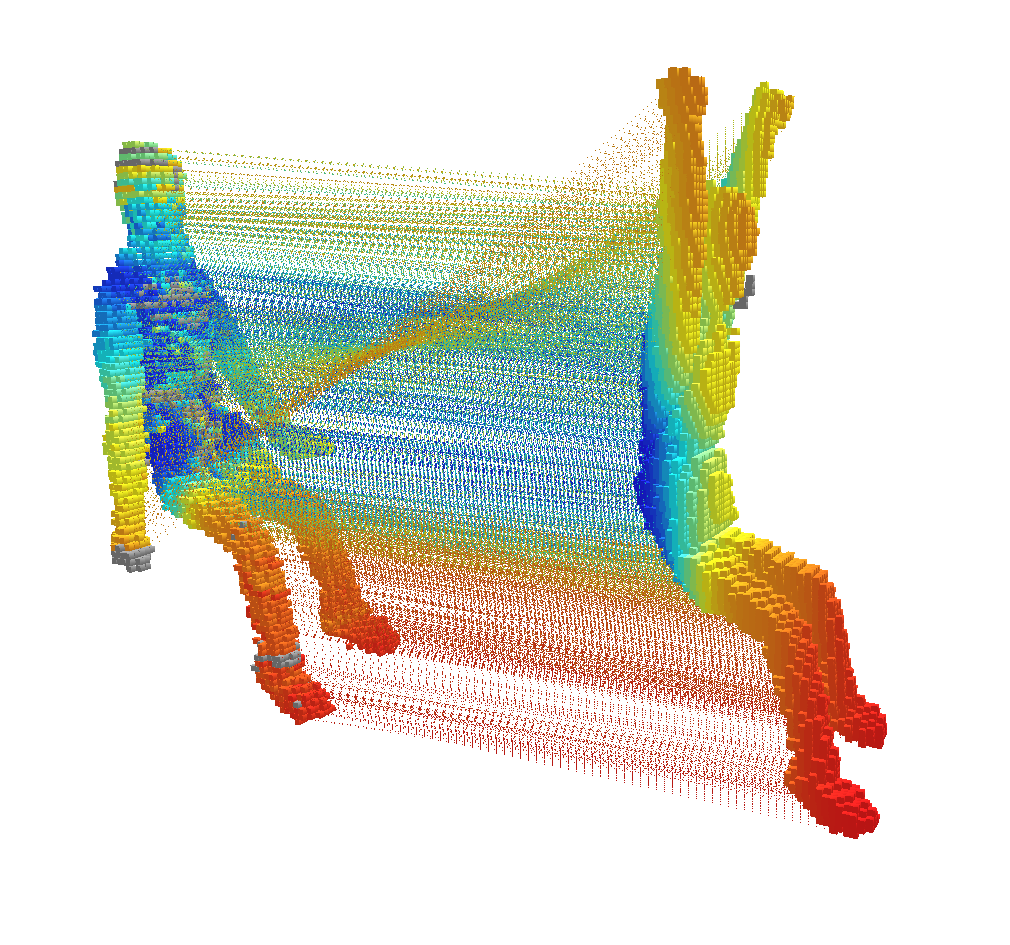  Project Webpage Code |
Unsupervised Articulated Shape Representation, Segmentation and Registration
INRIA Rhone-Alpes, Perception Group. Grenoble, France. RELATED PUBLICATIONS:
|
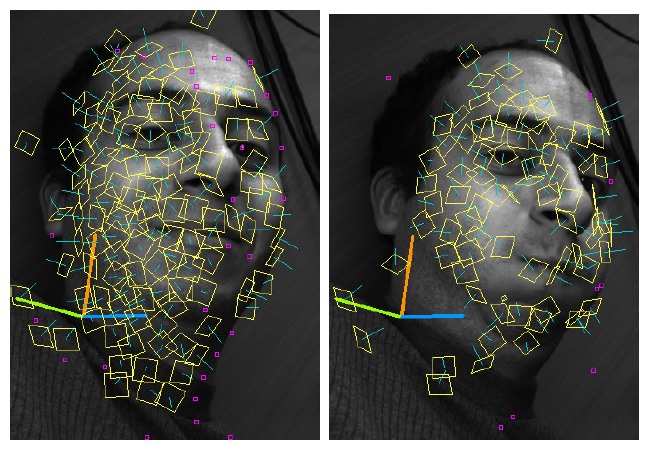
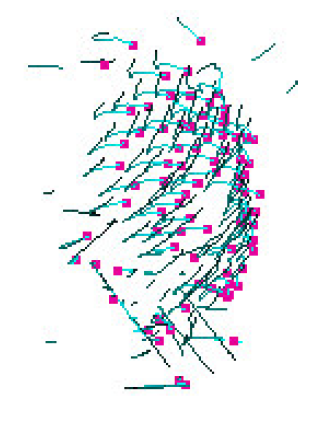
|
Sparse Scene Flow
INRIA Rhone-Alpes, Perception Group. Grenoble, France. (2004-2007) The scene-flow is a 3-D vector field describing the motion of objects present in a scene. In this project we develop a multiple-camera extension of the Lucas-Kanade tracker. Analysis and algorithms are proposed for two types of descriptors: points and small oriented surface patches (surfels). A cost function is defined in each case as well as the iterative optimization update rules to minimize it. A pyramidal implementation is employed to deal with high-speed motion. The concatenation of scene flow vectors along time, gives rise to 3-D trajectories useful for motion analysis, e.g trough the segmentation of the trajectories in groups of coherent motion. RELATED PUBLICATIONS:
|
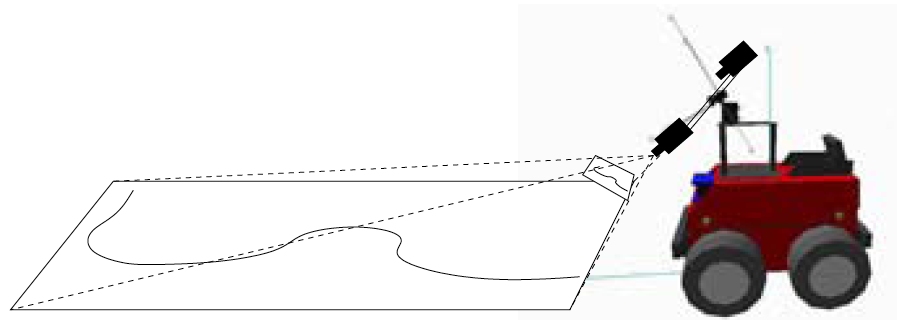

|
Visual control for robots in semi-structured outdoor environments
LAAS. RIA Group. Toulouse. France. 2003-2004. Project aimed to establish a navigation framework for robots in semi-structured outdoor environments enabling the execution of semantic tasks by chaining of elementary visually-based movement primitives. The visual control begins with the color segmentation of the images. The regions obtained are then identified as one of the previously learned classes (e.g sky, road, tree). Navigable regions are modeled and tracked with a an active contour. The objective of the internship was to design an algorithm able to dynamically plan short-term smooth trajectories for the robot to follow, and to control the execution of the designed path. RELATED PUBLICATIONS:
|


|
Localization and Navigation of Robots in Metric and Topological Environments
Universidad Javeriana. Electronics Engineering Department. Bogota. Colombia. 2002. Project comprising the conception of an autonomous mobile robot, Macondo, starting from the hardware and mechanical design, trough the design of the embedded systems for perception and control, and concluding by the development of the navigation tasks (low-level control, localization, path planning). The environment is assumed to be known and is represented with a hybrid, metric (occupation grid) and topological (graph), map. The robot uses genetic algorithms and an A* for path planning, and a Markov Localization method to determine position inside the representation by taking into account the incoming information from different sensors. Both path planning and localization tasks were efficiently programmed in low-level microprocessors languages. RELATED PUBLICATIONS:
|
Short Bio
I'm research scientist at the joint Research Group between the Institute of Computational Biology (Helmholtz Zentrum) and the Chair for Computer Aided Medical Procedures (Technical University of Munich). I did my PhD, at the PERCEPTION Team- INRIA Rhone-Alpes (Grenoble 2004-2008) under the supervision of Radu Horaud. My doctoral thesis focused on the registration and segmentation of articulated shapes, using a geometric interpretation of spectral embedding methods (generally used for manifold learning). It also included a general method for estimating the Scene-Flow (3-D optical flow) from image sequences obtained with a multiple-camera set-up, as well as the the segmentation of the resultant scene-flow trajectories in groups of coherent motion. The PhD was part of the FP6 Marie Curie EST Visitor project.
My previous research work pointed to robotics applications devoted to localization and visual navigation. I completed a research MSc. (MsC./DEA) in Automation Systems (Toulouse 2003-2004) at the LAAS laboratory in the Robotics, Action and Perception Group (previous RIA team), under the direction of Michel Devy and in collaboration with Gabriel Avina. I obtained my Bachelors in Electronics Engineering in the Javeriana University (Bogota-Colombia 1996-2002).
Editorial, Tutorials and Workshops
- Main organiser of the MICCAI 2016 Workshop on "Large-scale Annotation of Biomedical data and Expert Label Synthesis" (LABELS)

- Main organiser of the 2011 MICCAI Tutorial: Manifold Learning with Medical Images

- PC-member of GCPR 2013(GCPR = German Conference on Pattern Recognition, formerly known as DAGM)
- Associate Editor: ICPR 2012, 2014.
- Journal Reviewer: IJCV,CVIU, PAMI, Trans. on Cybernetics
- Conferences Reviewer: CVPR (Outstanding Reviewer Award 2010), ECCV, 3DPVT, ACCV, DAGM
Publications
| 2020 | |
| , A. Kazi, S. Albarqouni, , P. Biberthaler, N. Navab, , D. Mateus
Precise proximal femur fracture classification for interactive training and surgical planning Int. J. Comput. Assist. Radiol. Surg. 2020, 15(5), pp.847-857. (bib) |
|
| 2019 | |
| A. Jiménez-Sánchez, A. Kazi, S. Albarqouni, C. Kirchhoff, , , D. Mateus, C. Kirchhoff
Towards an Interactive and Interpretable CAD System to Support Proximal Femur Fracture Classification (pre-print version is available online at arXiv) (bib) |
|
| 2018 | |
| A. Kazi, A. Jiménez-Sánchez, S. Albarqouni, C. Kirchhoff, , P. Biberthaler, D. Mateus, N. Navab
Weakly-Supervised Localization and Classificationof Proximal Femur Fractures (pre-print version is available online at arXiv) (bib) |
|
| A. Sanchez, S. Albarqouni, D. Mateus
Capsule Networks against Medical Imaging Data Challenges Proceedings of MICCAI Workshop on Large-scale Annotation of Biomedical data and Expert Label Synthesis, Granada, Spain, September 2018 A pre-print version is available online at arXiv. (bib) |
|
| D. Stoyanov, R. Taylor, S. Balocco, R. Sznitman, A. Martel, L. Maier-Hein, L. Duong, G. Zahnd, S. Demirci, S. Albarqouni, J. Lee, S. Moriconi, V. Cheplygina, D. Mateus, E. Trucco, E. Granger, P. Jannin
Intravascular Imaging and Computer Assisted Stenting and Large-Scale Annotation of Biomedical Data and Expert Label Synthesis MICCAI 2018 Workshops (bib) |
|
| F. Navarro, N. Navab, D. Mateus
Optical classification of neoplastic colorectal polyps - a computer-assisted approach (the COACH study) Journal, Scandinavian Journal of Gastroenterology (bib) |
|
| L. Casas, C. Muerwald, F. Achilles, D. Mateus, D. Huber, N. Navab, S. Demirci
Human Pose Estimation from Pressure Sensor Data Bildverarbeitung fuer die Medizin 2018, pp 285-290 (bib) |
|
| 2017 | |
| A. Kazi, S. Albarqouni, A. Sanchez, C. Kirchhoff, P. Biberthaler, N. Navab, D. Mateus
Automatic Classification of Proximal Femur Fractures based on Attention Models Proceedings of MICCAI Workshop on Machine Learning in Medical Imaging (MLMI), Quebec, Canada, September 2017 (bib) |
|
| J. Cardoso, T. Arbel, J. Lee, V. Cheplygina, S. Balocco, D. Mateus, G. Zahnd, L. Maier-Hein, S. Demirci, E. Granger, L. Duong, M. A. Carbonneau, S. Albarqouni, G. Carneiro
Intravascular imaging and computer assisted stenting, and large-scale annotation of biomedical data and expert label synthesis MICCAI 2017 Workshops (bib) |
|
| F. Navarro, D. Mateus, N. Navab
Computer assisted optical biopsy for colorectal polyps Proceedings of the SPIE Medical Imaging, 2017, Orlando, Florida, United States (bib) |
|
| L. Peter, D. Mateus, P. Chatelain, D. Declara, N. Schworm, S. Stangl, G. Multhoff, N. Navab
Assisting the Examination of Large Histopathological Slides with Adaptive Forests Medical Image Analysis, Vol. 35, January 2017 (bib) |
|
| 2016 | |
| M. Simonovsky, B. Gutierrez-Becker, D. Mateus, N. Navab, N. Komodakis
A Deep Metric for Multimodal Registration Proceedings of the 19th International Conference on Medical Image Computing and Computer Assisted Intervention (MICCAI), Athens, Greece, October 2016 (bib) |
|
| B. Gutierrez-Becker, D. Mateus, L. Peter, N. Navab
Learning Optimization Updates for Multimodal Registration Proceedings of the 19th International Conference on Medical Image Computing and Computer Assisted Intervention (MICCAI), Athens, Greece, October 2016 (bib) |
|
| 2015 | |
| M. Zweng, P. Fallavollita, S. Demirci, M. Kowarschik, N. Navab, D. Mateus
Automatic Guide-Wire Detection for Neurointerventions Using Low-Rank Sparse Matrix Decomposition and Denoising MICCAI 2015 Workshop on Augmented Environments for Computer-Assisted Interventions (bib) |
|
| L. Peter, O. Pauly, P. Chatelain, D. Mateus, N. Navab
Scale-Adaptive Forest Training via an Efficient Feature Sampling Scheme Proceedings of the 18th International Conference on Medical Image Computing and Computer Assisted Intervention (MICCAI), Munich, Germany, October 2015 (bib) |
|
| C. Hennersperger, M. Baust, D. Mateus, N. Navab
Computational Sonography MICCAI 2015, the 18th International Conference on Medical Image Computing and Computer Assisted Intervention (bib) |
|
| B. Gutierrez-Becker, D. Mateus, N. Navab
A Low-Rank Sparse Approach to Reconstruct Incomplete Shapes SHAPE Symposium 2015 (bib) |
|
| D. Volpi, M. H. Sarhan, R. Ghotbi, N. Navab, D. Mateus, S. Demirci
Online Tracking of Interventional Devices for Endovascular Aortic Repair International Journal of Computer Assisted Radiology and Surgery, June 2015, Volume 10, Issue 6, pp 773-781 (bib) |
|
| 2014 | |
| L. Peter, D. Mateus, P. Chatelain, N. Schworm, S. Stangl, G. Multhoff, N. Navab
Leveraging Random Forests for Interactive Exploration of Large Histological Images Proceedings of the 17th International Conference on Medical Image Computing and Computer Assisted Intervention (MICCAI), Boston, Massachusetts, United States, September 2014 (bib) |
|
| C. Hennersperger, D. Mateus, M. Baust, N. Navab
A Quadratic Energy Minimization Framework for Signal Loss Estimation from Arbitrarily Sampled Ultrasound Data Medical Image Computing and Computer-Assisted Intervention, MICCAI 2014, Lecture Notes in Computer Science Volume 8674, 2014, pp 373-380 (bib) |
|
| V. Castaneda, D. Mateus, N. Navab
Stereo Time-of-Flight with Constructive Interference IEEE Transactions on Pattern Analysis and Machine Inteligence (TPAMI) Volume 36, number 7, pages 1402-1423, 2014. (bib) |
|
| N. Rieke, C. Hennersperger, D. Mateus, N. Navab
Ultrasound Interactive Segmentation with Tensor-Graph Methods IEEE International Symposium on Biomedical Imaging (ISBI), Beijing, China, April 2014 (bib) |
|
| B. Gutierrez-Becker, D. Mateus, E. Shiban, B. Meyer, J. Lehmberg, N. Navab
A Sparse Approach to Build Shape Models with Routine Clinical Data International Symposium on Biomedical Imaging 2014 (bib) |
|
| 2012 | |
| T. Birdal, D. Mateus, S. Ilic
Towards A Complete Framework For Deformable Surface Recovery Using RGBD Cameras IEEE IROS'12 Workshop on Color-Depth Fusion in Robotics, Vila Moura, Portugal, October 2012 (bib) |
|
| A. Sharma, R. Horaud, D. Mateus
3D Shape Registration Using Spectral Graph Embedding and Probabilistic Matching 2012. Olivier Lezoray and Leo Grady (Eds.), "Image Processing and Analysis with Graphs: Theory and Practice" (Chapter 8), Digital Imaging and Computer Vision Series, CRC Press. (bib) |
|
| L. Schwarz, A. Mkhitaryan, D. Mateus, N. Navab
Human Skeleton Tracking from Depth Data Using Geodesic Distances and Optical Flow Image and Vision Computing, Volume 30 (2012), p. 217-226 (bib) |
|
| L. Schwarz, D. Mateus, N. Navab
Recognizing Multiple Human Activities and Tracking Full-Body Pose in Unconstrained Environments Pattern Recognition, Volume 45 (2012), p. 11-23 (bib) |
|
| Y. Chen, T. Hrabe, S. Pfeffer, O. Pauly, D. Mateus, N. Navab, F. Foerster
Detection and Identification of Macromolecular Complexes in Cryo-Electron Tomograms Using Support Vector Machines IEEE International Symposium on Biomedical Imaging: From Nano to Macro (ISBI 2012), Barcelona, Spain, May 2 - 5, 2012 (bib) |
|
| D. Mateus, C. Wachinger, S. Atasoy, L. Schwarz, N. Navab
Learning Manifolds: Design Analysis for Medical Applications 2012. Kenji Suzuki (Ed.), "Machine Learning in Computer-Aided Diagnosis: Medical Imaging Intelligence and Analysis", pp. 403-418. IGI Global, doi:10.4018/978-1-4666-0059-1. (bib) |
|
| S. Atasoy, D. Mateus, A. Meining, G. Z. Yang, N. Navab
Endoscopic Video Manifolds for Targeted Optical Biopsy IEEE Transactions on Medical Imaging. (bib) |
|
| 2011 | |
| S. Atasoy, D. Mateus, A. Meining, G. Z. Yang, N. Navab
Targeted Optical Biopsies for Surveillance Endoscopies Medical Image Computing and Computer Assisted Intervention (MICCAI), Toronto, Canada, September 20-24 2011. (bib) |
|
| O. Pauly, D. Mateus, N. Navab
STARS: A New Ensemble Partitioning Approach ICCV Workshop on Information Theory in Computer Vision and Pattern Recognition (ITINCVPR 2011), Madrid, Spain, November 2011 (bib) |
|
| V. Castaneda, D. Mateus, N. Navab
Stereo Time-of-Flight IEEE International Conference on Computer Vision (ICCV), Barcelona, Spain, November 2011. (bib) |
|
| A. Safi, M. Baust, O. Pauly, V. Castaneda, T. Lasser, D. Mateus, N. Navab, R. Hein, M. Ziai
Computer-Aided Diagnosis of Pigmented Skin Dermoscopic Images MICCAI Workshop on Medical Content-based Retrieval for Clinical Decision Support, Toronto, Canada, September 2011 (bib) |
|
| O. Pauly, D. Mateus, N. Navab
Building Implicit Dictionaries based on Extreme Random Clustering for Modality Recognition MICCAI Workshop on Medical Content-based Retrieval for Clinical Decision Support, Toronto, Canada, September 2011 (bib) |
|
| O. Pauly, B. Glocker, A. Criminisi, D. Mateus, A. Martinez-Möller, S. Nekolla, N. Navab
Fast Multiple Organs Detection and Localization in Whole-Body MR Dixon Sequences To appear in Proc. Medical Image Computing and Computer-Assisted Intervention (MICCAI 2011), Toronto, Canada, September 2011 (bib) |
|
| L. Schwarz, A. Mkhitaryan, D. Mateus, N. Navab
Estimating Human 3D Pose from Time-of-Flight Images Based on Geodesic Distances and Optical Flow IEEE Conference on Automatic Face and Gesture Recognition (FG), Santa Barbara, USA, March 2011 (bib) |
|
| A. Safi, V. Castaneda, T. Lasser, D. Mateus, N. Navab
Manifold Learning for Dimensionality Reduction and Clustering of Skin Spectroscopy Data Proceedings of SPIE (2011) (bib) |
|
| L. Schwarz, D. Mateus, J. Lallemand, N. Navab
Tracking Planes with Time of Flight Cameras and J-linkage IEEE Workshop on Motion and Video Computing, Winter Vision Meetings, Hawaii, January 2011 (bib) |
|
| V. Castaneda, D. Mateus, N. Navab
SLAM combining ToF and High-Resolution cameras IEEE Workshop on Motion and Video Computing, Winter Vision Meetings, Hawaii, January 2011 (bib) |
|
| 2010 | |
| S. Atasoy, D. Mateus, J. Lallemand, A. Meining, G. Z. Yang, N. Navab
Endoscopic Video Manifolds Medical Image Computing and Computer Assisted Intervention (MICCAI), Beijing, China, September 20-24 2010. (bib) |
|
| S. Atasoy, D. Mateus, A. Georgiou, N. Navab, G. Z. Yang
Wave Interference for Pattern Description Asian Conference on Computer Vision (ACCV), Queenstown, New Zealand, November 8-12 2010. (bib) |
|
| O. Pauly, D. Mateus, N. Navab
ImageCLEF 2010 Working Notes on the Modality Classification Subtask. Cross Language Image Retrieval Workshop (ImageCLEF? 2010), Medical Retrieval, Padua, Italy, September 2010 (bib) |
|
| L. Schwarz, D. Mateus, V. Castaneda, N. Navab
Manifold Learning for ToF-based Human Body Tracking and Activity Recognition British Machine Vision Conference (BMVC), Aberystwyth, United Kingdom, August 2010 (bib) |
|
| L. Schwarz, D. Mateus, N. Navab
Multiple-Activity Human Body Tracking in Unconstrained Environments Articulated Motion and Deformable Objects, VI International Conference, Port d'Andratx, Mallorca, Spain, July 2010 (bib) |
|
| L. Schwarz, D. Mateus, J. Remi, S. Noachtar, N. Navab
Ambulatory Human Motion Analysis Using a Portable Full-body Tracking System Wearable Micro and Nano Technologies for Personalized Health, 7th International Conference, Berlin, Germany, May 2010 (bib) |
|
| C. Wachinger, D. Mateus, A. Keil, N. Navab
Manifold Learning for Patient Position Detection in MRI IEEE International Symposium on Biomedical Imaging (ISBI), Rotterdam, The Netherlands, April 14 - 17 2010. (bib) |
|
| 2009 | |
| S. Atasoy, B. Glocker, S. Giannarou, D. Mateus, A. Meining, G. Z. Yang, N. Navab
Probabilistic Region Matching in Narrow-Band Endoscopy for Targeted Optical Biopsy Medical Image Computing and Computer Assisted Intervention (MICCAI), London, UK, September 20-24 2009. (bib) |
|
| L. Schwarz, D. Mateus, N. Navab
Discriminative Human Full-Body Pose Estimation from Wearable Inertial Sensor Data 3D Physiological Human (3DPH), 2nd International Workshop, Zermatt, Switzerland, November 2009 (bib) |
|
| N. Padoy, D. Mateus, D. Weinland, M.O. Berger, N. Navab
Workflow Monitoring based on 3D Motion Features ICCV Workshop on Video-oriented Object and Event Classification, Kyoto, Japan, September 2009 (IBM Best Paper Award) (bib) |
|
| V. Castaneda, S. Atasoy, D. Mateus, N. Navab, A. Meining
Reconstructing the Esophagus Surface from Endoscopic Image Sequences 5th Russian-Bavarian Conference on Bio-Medical Engineering, Munich, Germany, July 1-4 2009. (bib) |
|
Other Publications
- Multiple-Activity Human Body Tracking in Unconstrained Environments. L. Schwarz, D. Mateus, N. Navab Articulated Motion and Deformable Objects, VI International Conference, Port d'Andratx, Mallorca, Spain, July 2010. (Best Paper Award)
- Workflow Monitoring based on 3D Motion Features. N. Padoy, D. Mateus, D. Weinland, M.O. Berger, N. Navab. ICCV Workshop on Video-oriented Object and Event Classification, Kyoto, Japan, September 2009 (IBM Best Paper Award).
- Spectral Tools for Unsupervised Modeling of Articulated Objects from Multiple-view Videos. Diana Mateus. INRIA Grenoble (Institut National de Recherche en Informatique et Automatique) and Institute National Polythechnique de Grenoble (INPG). September 2009.
- Inexact Matching of Large and Sparse Graphs Using Laplacian Eigenvectors. David Knossow, Avinash Sharma, Diana Mateus and Radu Horaud. Proceedings of 7th Workshop on Graph-based Representations in Patterns Recognition - GBR 2009.
- Articulated Shape Matching Using Laplacian Eigenfunctions and Unsupervised Point Registration. Diana Mateus, Radu P. Horaud, David Knossow, Fabio Cuzzolin, Edmond Boyer. Proceedings of the IEEE Conference on Computer Vision and Pattern Recognition - CVPR 2008
- Coherent Laplacian 3-D Protrusion Segmentation. Fabio Cuzzolin, Diana Mateus, David Knossow, Edmond Boyer, Radu P. Horaud. Proceedings of the IEEE Conference on Computer Vision and Pattern Recognition - CVPR 2008
- Articulated Shape Matching by Robust Alignment of Embedded Representations. Diana Mateus, Fabio Cuzzolin, Radu P. Horaud, Edmond Boyer. IEEE Workshop on 3D Representation for Recognition (3DRR 2007) - October 2007
- Articulated Shape Matching Using Locally Linear Embedding and Orthogonal Alignment. Diana Mateus, Fabio Cuzzolin, Radu P. Horaud, Edmond Boyer. IEEE Workshop on Non-rigid Registration and Tracking through Learning - NRTL 2007 - October 2007
- Robust Spectral 3D-bodypart Segmentation along Time. Fabio Cuzzolin, Diana Mateus, Edmond Boyer, Radu P. Horaud. Second Workshop on Human Motion, Understanding, Modeling, Capture and Animation, Volume 4814, Pages 196--211 - October 2007
- Spectral Methods for 3-D Motion Segmentation of Sparse Scene-Flow. Diana Mateus, Radu P. Horaud. IEEE Workshop on Motion and Video Computing, WMVC 2007
- Multi-Camera Scene Flow by Tracking 3-D Points and Surfels. Frédéric Devernay, Diana Mateus, Matthieu Guilbert. Proceedings of the IEEE Conference on Computer Vision and Pattern Recognition - CVPR 2006
